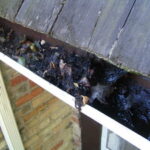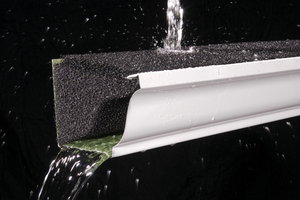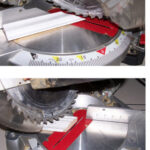As a general rule, home gutter repair is not something that should have to be done often, but gutter repairs do come up from time to time. Whether dealing with a persistent miter leak or a gutter holding water, homeowners need to be prepared to keep their gutters functioning.
Gutter leaks and drainage problems can lead to roof damage, foundation problems and cracks in driveways and sidewalks, among other issues. Following these steps to troubleshoot and repair a home’s gutters can help keep them working well over the years and extend their life, saving money on replacement own the road.
Directions for Repairing a Leaky Miter
- Clean out the area surrounding the affected miter. If necessary, clean out the gutters entirely. The miter itself needs to be clean and dry before a leak can be repaired. After cleaning out any debris, wipe the miter clean with a cloth or towel to get any dirt or grime off the surface. The cleaner the miter can be, the better the repair will go.
- Gutter seal sticks best on a new or clean surface. Use gutter seal rather than a general exterior caulk, because it will tend to flex better with the metal in changing seasons, and will self-level to a large extent, bonding with the miter and covering the leak. Gutter seal can be purchased at any home improvement warehouse or gutter supplier. Most suppliers will carry a product superior to those available at public home improvement warehouses, though it may cost a bit more to purchase.
- After the miter is clean and free of any water, apply the gutter seal across the entire seam, right over top of the existing caulk. If necessary, it is also possible to strip off the old caulk and start fresh, but this cannot always easily be done. The important thing is to start with an area as clean and dry as possible. Do not try to repair a miter leak in the rain.
- After applying the gutter seal across the seam, use a wet finger or a piece of cardboard or scrap fragment of metal to smooth out the bead, encouraging it to lay flat and to bond with the gutter and the existing gutter seal. Do not spread the material out too far and remove it from the seam, just encourage it to spread a bit flatter and make sure it bonds with the gutter surface. Most gutter seals are self-leveling, but doing this while applying the seal and helping promote the process will prevent another trip up the ladder later.
- Most gutter seals are watertight as soon as they are installed. Test out the repair with a garden hose as soon as the seal has skinned over.
Directions for Repairing a Poorly Pitched Gutter
- To diagnose a problem with a gutter’s pitch, clean out the entire gutter of any debris. Standing water in any part of the gutter will be a sure sign of a poorly pitched gutter. In cases when it hasn’t rained in a while, however, it may be harder to tell. Look for sags in the front face of the gutter, signs of strain during inclement weather. Check the pitch with a level as well. Any areas not draining toward a local downspout need to be adjusted.
- To re-pitch a section of gutter, remove the gutter spikes or hangers and adjust the pitch by pushing the gutter up. Check the pitch before reinstalling spikes or hanger screws. The gutter should be draining toward the downspout. On the level, the bubble should be just touching the line, away from the direction of water flow.
- While adjusting gutter pitch, consider checking all hanger screws or gutter spikes to make sure they are driven in all the way. They can come loose over time, compromising the gutter’s pitch and causing sagging in the front, a problem which compounds itself over time and leads to gutters holding water (and ice in the winter). Drive in all spikes and finish all screws so that the front face of the gutter is uniform with no waviness present.





